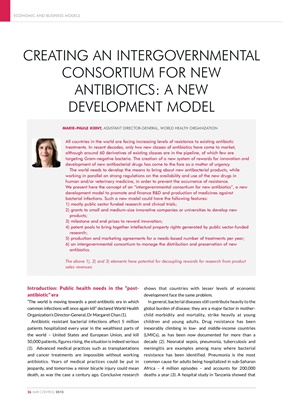
ECONOMIC AND BUSINESS MODELS
26 AMR CONTROL 2015
Introduction: Public health needs in the "postantibiotic"
era
"The world is moving towards a post-antibiotic era in which
common infections will once again kill" declared World Health
Organization's Director-General, Dr Margaret Chan (1).
Antibiotic resistant bacterial infections affect 5 million
patients hospitalized every year in the wealthiest parts of
the world - United States and European Union, and kill
50,000 patients, figures rising, the situation is indeed serious
(1). Advanced medical practices such as transplantations
and cancer treatments are impossible without working
antibiotics. Years of medical practices could be put in
jeopardy, and tomorrow a minor bicycle injury could mean
death, as was the case a century ago. Conclusive research
shows that countries with lesser levels of economic
development face the same problem.
In general, bacterial diseases still contribute heavily to the
global burden of disease; they are a major factor in motherchild
morbidity and mortality, strike heavily at young
children and young adults. Drug resistance has been
inexorably climbing in low- and middle-income countries
(LMICs), as has been now documented for more than a
decade (2). Neonatal sepsis, pneumonia, tuberculosis and
meningitis are examples among many where bacterial
resistance has been identified. Pneumonia is the most
common cause for adults being hospitalized in sub-Saharan
Africa - 4 million episodes - and accounts for 200,000
deaths a year (3). A hospital study in Tanzania showed that
CREATING AN INTERGOVERNMENTAL
CONSORTIUM FOR NEW
ANTIBIOTICS: A NEW
DEVELOPMENT MODEL
MARIE-PAULE KIENY, ASSISTANT DIRECTOR-GENERAL, WORLD HEALTH ORGANIZATION
All countries in the world are facing increasing levels of resistance to existing antibiotic
treatments. In recent decades, only two new classes of antibiotics have come to market,
although around 60 derivatives of existing classes are in the pipeline, of which few are
targeting Gram-negative bacteria. The creation of a new system of rewards for innovation and
development of new antibacterial drugs has come to the fore as a matter of urgency.
The world needs to develop the means to bring about new antibacterial products, while
working in parallel on strong regulations on the availability and use of the new drugs in
human and/or veterinary medicine, in order to prevent the occurrence of resistance.
We present here the concept of an "intergovernmental consortium for new antibiotics", a new
development model to promote and finance R&D and production of medicines against
bacterial infections. Such a new model could have the following features:
1) mostly public sector funded research and clinical trials;
2) grants to small and medium-size innovative companies or universities to develop new
products;
3) milestone and end prizes to reward innovation;
4) patent pools to bring together intellectual property rights generated by public sector-funded
research;
5) production and marketing agreements for a needs-based number of treatments per year;
6) an intergovernmental consortium to manage the distribution and preservation of new
antibiotics.
The above 1), 2) and 3) elements have potential for decoupling rewards for research from product
sales revenues.